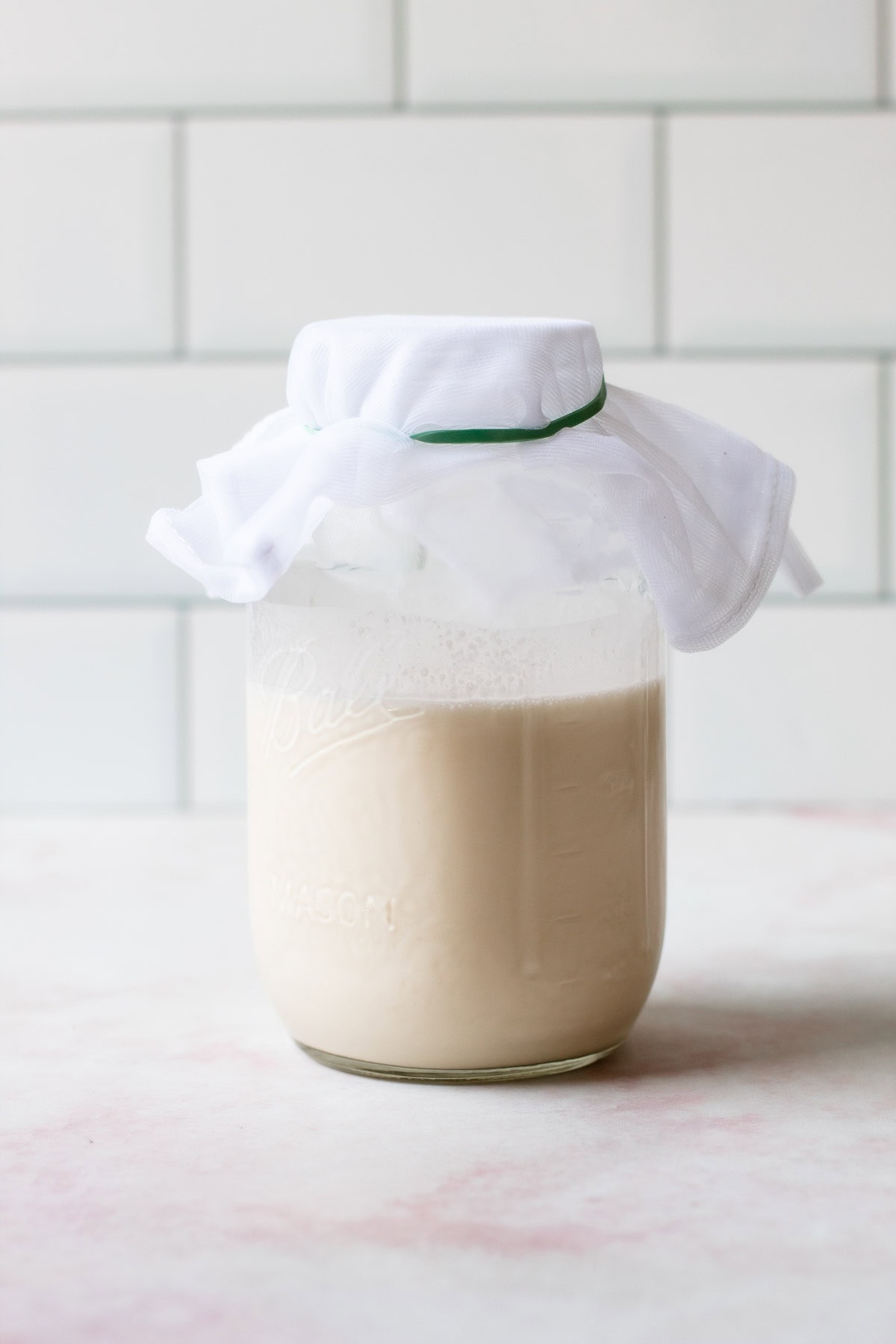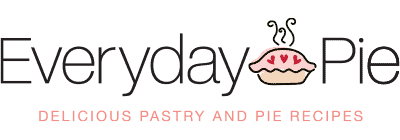Learn How to Make the Crème Fraîche at home, using two simple ingredients, with this easy tutorial.

Want to save this recipe?
Enter your email & I'll send it to your inbox. Plus, get weekly updates from me!
Rich, creamy, and slightly tangy, crème fraîche is the smoother and sophisticated cousin of sour cream. The name crème fraîche, of course, comes from France and translates as "fresh cream." In France, it was traditionally made with an unpasteurized cream that contains natural bacteria, which allows the cream to ferment and thicken. Over here in the US, most states prohibit the sale of unpasteurized dairy, so bacteria must be manually introduced. This homemade version is made with only two ingredients: cream and buttermilk.
Not only is it fun to play scientist for a day and ferment dairy at home, but making your own creme fraiche is also economical. Much like other specialty items like Lemon Curd, or Whipped Cream, and Caramel Sauce, they come at a premium price at the store, with quality a hit or miss. You can make double to triple the amount of crème fraîche for the same price as you would buy in the store. Plus, it's made with simple ingredients you often have on hand, and I can guarantee it's going to be better quality!
So, let's get into it! This post contains everything you need to know about Homemade Crème Fraiche. You can navigate using the menu below or skip to the end of the article for the full recipe.

Ingredients and Equipment Needed
To make this you need just two ingredients:
- Heavy Cream: Look for homogenized and pasteurized. I don't recommend using unhomogenized cream here because your finished product won't be smooth. In addition, if you bake with it, it could break. Some creams are ultra-pasteurized, which means that it is heated to a very high temperature to kill off nearly all bacteria. It's best to avoid this for making creme fraiche, because there is a chance it might not ferment.
- Cultured Buttermilk: It's important you buy buttermilk that says it is cultured, which means it has the bacteria you need to ferment the cream! You cannot use homemade buttermilk that is made up of milk and lemon juice. It is possible to use another cultured dairy, such as yogurt or sour cream, but I suggest sticking with the cultured buttermilk for the best results.
The equipment you need is also pretty straight forward:
- Clean non-reactive jar or bowl: I prefer to use a mason jar. It's simple, with a small opening to easily cover and glass is perfect for fermenting dairy. Fermenting dairy has acid; using a reactive metal will give an off taste to the finished creme fraiche and could interfere with the process.
- Cheesecloth or a thin, clean kitchen towel: This covers the cream to prevent any dust or debris from getting in, but still allows the creme to breathe and let off any gas it is producing during the fermentation. I've also used a nut milk bag, as well.
- An elastic: This is just to keep the cheesecloth or towel secure.
An Overview on Fermentation
Making creme fraiche at home relies on the process of fermentation. Yes, it sounds intimidating. In a nutshell, dairy fermentation is the act of introducing bacteria to milk or cream, which then creates a comfortable environment for the bacteria to grow for a specified period of time. The introduced bacteria--which in this case is in the buttermilk--will feed off the sugar in the cream, transforming that sugar to acid. The acid drops the pH of the cream, creating an unsafe environment for bad bacteria to grow that can make you sick, yet creates a healthy environment for the good bacteria to thrive. As this occurs, the cream thickens and becomes slightly tangy. The longer you ferment the bacteria, the thicker and tangier the creme fraiche becomes. How long the process takes entirely depends on the environmental conditions in your home.
The Importance of Starting with Clean Equipment and Utensils
Whenever you are fermenting anything, you want to make sure any equipment and utensils being utilized are well cleaned, as you don’t want to encourage the growth of bad bacteria. Clean all your utensils and cookware and anything else you are going to use with hot soapy water, or better yet, place them in the dishwasher.
A Note about Ambient Temperature
In order for dairy to ferment, there are two key pieces that must be in place: the right kind of bacteria and the right ambient temperature. For creme fraiche, a good temperature is about 70ºF, which tends to be about room temperature. If your house is very cold, or if the cream is left in a drafty area, it might take longer to ferment. On the other end, if your house is very hot (say 80ºF or above), the dairy can ferment very quickly. You'll know it's ready when it has thickened up and smells fresh and tangy.
Step-by-Step Visual Overview
Here is a quick overview of the steps needed to make crème fraîche at home . This is not the actual recipe, which is located at the end of this article and has much greater detail to ensure success.

Step 1: Stir together buttermilk and cream.

Step 2: Cover the opening with a breathable material.

Step 3: Ferment at room temperature.

Step 4: It's ready when thickened, giving off a delightful tangy, fresh scent reminiscent of buttermilk.
Homemade Crème Fraîche FAQs
Find some frequently asked questions about making crème fraîche at home here.
This can vary, given that creme fraiche contains healthy and active bacteria. It will depend on how fresh the ingredients were when you made your creme fraiche. What makes it turn dangerous to eat is the overgrowth of bad bacteria. Generally speaking, it can last up to two weeks. Some indicators that the product has turned unsafe to eat are a change in color, any visible mold growth, or a change in smell. It's okay--and expected-- for the creme fraiche to harbor a slightly sour smell, but it should be pleasant smell, such as buttermilk. If it has an off smell, or simply doesn't smell fresh to you, it's certainly time to toss it!
It might be possible to make creme fraiche with ultrapasteurized cream, but it isn't recommended. Ultrapasteurized milk is heated at an extreme temperature, which really changes the makeup of the dairy, including killing off nearly any bacteria present, whether good or bad. There is a chance creme fraiche might not be successful with ultrapasteurized cream because it isn't able to grow the bacteria needed. In addition to this, it won't have the same unique taste that you expect with creme fraiche.
Yes, but I don't recommend it. Unhomogenized milk means there is a layer of thickened cream that separates from the lighter cream, and it can result in your final creme fraiche not being very smooth. While the flavor can be superior, another downside can be that the creme fraiche can also separate during baking. So generally speaking, I recommend using homogenized cream.
If your house is hot, as in above 70ºF, you'll have to keep a closer eye on the fermenting cream. It will likely ferment in less time. Once it's thickened, it's best to move it to the refrigerator.
The creme fraiche might not ferment! The bacteria needs a warm enough environment to grow, so if it is too cold, it may not ferment in the time it needs to. A quick fix to this problem is to place your jar of creme fraiche inside your oven with the light on. The heat from the light, while enclosed in a small space, will be enough to allow for fermentation.
It's possible for a mistake to happen along the way when you are fermenting dairy. Perhaps it's been left for too long, or some bad bacteria had been allowed to grow. This is very unlikely if following the directions to this recipe, but it is always a possibility. You'll know something has gone wrong with the fermentation process immediately from the smell. Creme fraiche should smell tangy, slightly acidic, but very fresh. If it ever smells very sour or just plain bad, there is a chance there is a problem, and it's better to toss it and start over. Also, if there is ever any change in color, any growth, or even some clear liquid pooling on top of the cream, it's better to start over.
As mentioned above, whenever you are fermenting food, you want to make sure your cookware and utensils are sanitary so as to discourage the growth of bad bacteria. Use non-reactive containers to avoid flavor alteration from metal reacting with lactic acid. Avoid porous plastic containers as they can retain flavors from previous foods.

Ways to Use Crème Fraîche
There are so many ways to use crème fraîche. It can be used in all the same recipes that call for sour cream, and then some. Creme fraiche is far more stable than sour cream, and it can be heated!
It pairs great with sweet treats and savory alike, such as
- pies and tarts (such as this Mascarpone Roasted Plum Pie and this Honeynut Squash Tart)
- cheesecake (or cheesecake adjacent recipes like Blueberry Cream Cheese Pie or Strawberry Cream Cheese Pie)
- whipped cream (like the whipped cream used on this Chocolate French Silk Pie)
- baked goods such as muffins and cakes
- as a replacement for sour cream
Storing It
Choose a nonreactive, nonporous container. To ensure the best results, avoid metal and porous plastic containers. Metal can react to the growth of lactic acid and can change the flavor of the creme fraiche in a very unpleasant way. And porous plastic can sometimes hold flavors from other foods and can transfer into the delicate cream. Always keep the container clean to discourage the growth of bad bacteria. I have found that a glass mason jar works best for this.

More Kitchen Tutorials
I am so honored when you make a recipe from my site! If you make this Homemade Crème Fraîche, please leave a star ⭐️⭐️⭐️⭐️⭐️ rating with your experience! If you have any questions about this recipe, feel free to comment here, and tag me on Instagram!
PrintFull Recipe
How to Make Crème Fraîche
It couldn't be simpler to make Crème Fraîche at home using two simple ingredients. Not only is making creme fraiche a fun project, but it's economical, too, since creme fraiche is an expensive store-bought specialty item. You can also customize it to how you like it in terms of tanginess by adding up to 1 additional tablespoon of buttermilk to the cream.
- Prep Time: 00:02
- Total Time: 12:02
- Yield: 2 cups
- Category: Tutorials
- Method: Fermentation
- Cuisine: French
Ingredients
- 2 cups heavy cream (not ultra-pasteurized)
- 2-3 tablespoons real cultured buttermilk
Instructions
- In a clean non-reactive container, such as a mason jar, combine heavy cream and buttermilk.
- Cover the opening with breathable material, such as cheesecloth or a thin kitchen towel, and secure with a rubber band.
- Let it sit to ferment at room temperature for 8-24 hours, until thickened.
- Store crème fraîche in a covered non-reactive container for up to 2 weeks in the refrigerator.
Notes
Make sure to start with clean utensils to prevent any growth of any lingering bad bacteria. Wash all equipment with warm soapy water, or run in the dishwasher.
Don't use ultra-pasteurized milk. The cream is heated to a very high temperature and can possibly prevent the creme fraiche from fermenting.
For a tangier creme fraiche, add 3 tablespoons of cultured buttermilk.
Some of the links on this page may be affiliate links. Everyday Pie is a participant in the Amazon Associates Program. As an Amazon Associate I earn from qualifying purchases, at no extra cost to you.








Leave a Reply